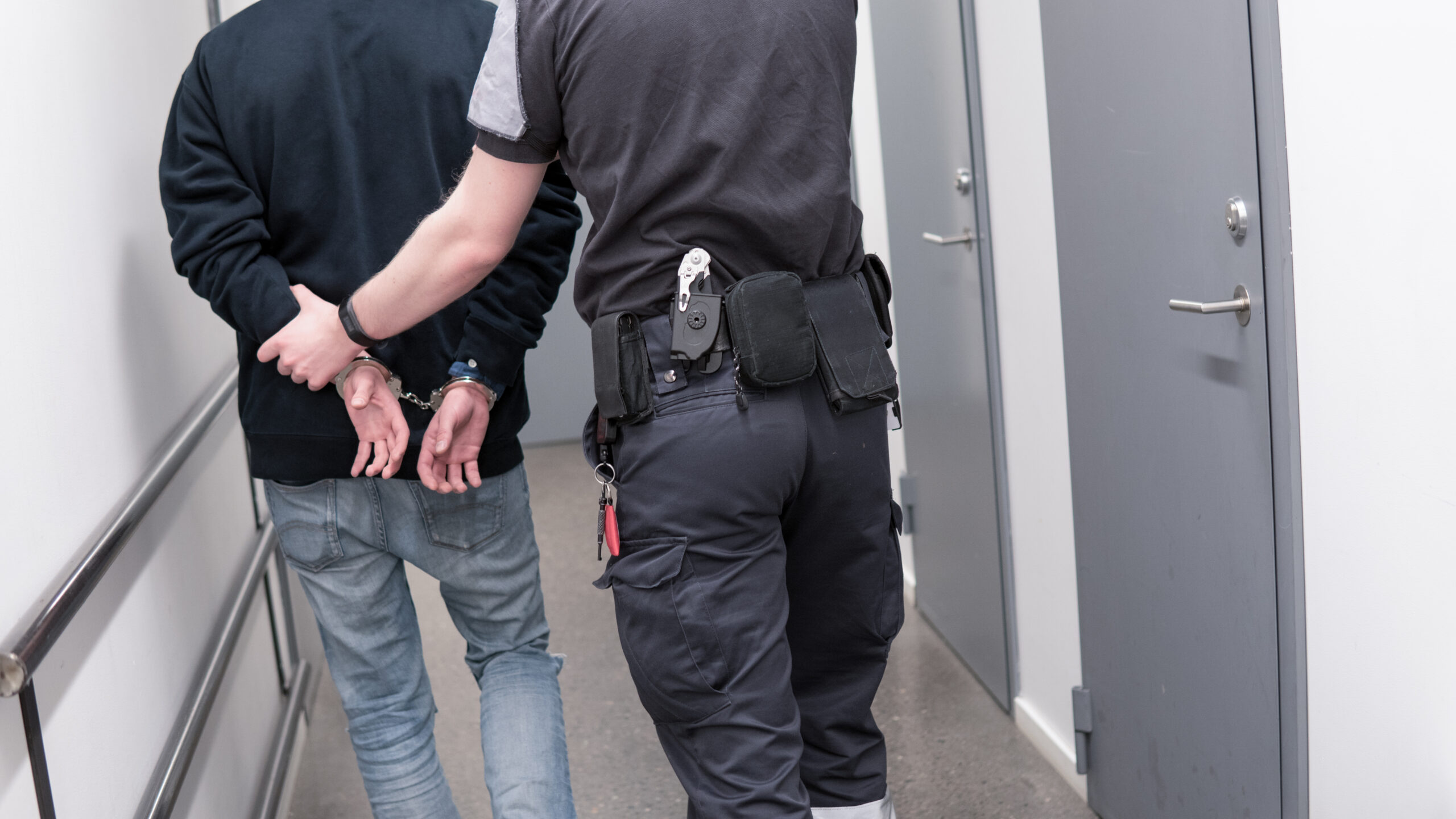
Mental Illness Shouldn’t Land You in Jail
Up to 40 percent of the people who end up behind bars in Travis County are in crisis. Diversion offers better options.
In February, Christine fought the devil at her boarding home in Austin.
At the time, she told us she wasn’t taking her medication. “And I saw the devil on the floor and he opened his mouth to swallow me whole.” Then she blacked out. She was told she had a seizure, and acted violently towards first responders. “I don’t know what’s going on with me at all,” she said.
Which is how, like so many others in America, she ended up in jail during a mental health crisis.
Christine—whose last name we’ve removed to protect her privacy—has suffered from seizures since she was 13, and was charged with misdemeanor assault on her roommate in February, after which she waited in the Travis County Jail for an IQ evaluation for over a month. She’s since been released with time served, but while there, she said she spent a night stripped to a smock in a padded cell alone—jail protocol for the highest level of suicide risk. She has no contact with family, only a friend and homeless advocate on the outside, Alvin Sanderson, who’s acted as her de facto case manager for her handful of assault charges, which all occurred during a mental health crisis. Christine described herself as having “a 16-year-old mind in a 38-year-old body. I just know that’s how my knowledge is.” Her case is all too common, not just in Travis County, but nationwide, as jails are forced to become first responders to a mental health crisis they are wholly unequipped to handle.
In the last few years, Travis County has seen a reckoning over its mass incarceration problem. In the summer of 2021, formerly incarcerated community organizers working with County Judge Andy Brown quashed efforts to construct a new women’s county jail in favor of reopening the long-range plan to rebuild and expand Travis County’s Correctional Complex in Del Valle. After commissioning a report on the county’s forensic mental health system from Dell Medical School at the University of Texas at Austin last May, the Travis County Commissioners Court unanimously voted on March 21 to begin designing a new booking facility and diversion center, where those who commit a crime during a mental health crisis can go instead of the jail, to be connected to services in the community.
But many questions remain as to how a diversion center will work: Who is ‘divertable’? When should they be diverted? And how to make sure they stay out of the carceral system and instead get the long-term treatment they need?
‘We’re so behind here’
Ten years ago, around 10 to 15 percent of people in the Travis County Jail had a mental health issue, said the jail’s director of mental health services, Danny Smith. Today it’s climbed to 40 percent. Brown often refers to the jail as the largest mental health facility in Travis County, and its numbers are consistent with the rest of the country’s jails. A Pew Research study from December 2022 found that at least 41 percent of U.S. adults experienced high levels of psychological distress since the beginning of the COVID-19 pandemic, and the World Health Organization found that in 2020 alone, global levels of anxiety and depression rose 25 percent. According to booking data from 2018-2022, the vast majority of charges this population had against them were nonviolent misdemeanors like criminal trespassing; only 7 percent were for assault, like in Christine’s case.
Travis County already offers a diversion option for 911, which dispatches the Expanded Mobile Crisis Outreach Team (EMCOT) through Integral Care, the county’s mental health authority, rather than normally trained police. EMCOT can connect the person with local hospitals or crisis residential services, but there are only 87 total beds in the system, and restrictions to admission and understaffing make accessing them difficult. The 911 call center itself is almost half-staffed, and though EMCOT promises 90 days of follow-up, including medication evaluation, when they cannot place an individual, the Dell report notes that it’s difficult for Integral Care to fulfill that promise due to understaffing.
County leaders also consistently note a lack of collaborative data sharing between departments, which slows down the process of connecting an individual with services. “When diversion into treatment fails,” notes the report, “people end up back where they started (too frequently homeless and on the streets) or are criminally charged.” If the latter happens, at Central Booking there’s no guaranteed defense lawyer present, which increases the likelihood of the individual taking a plea or facing the wrong charge.
“We’re so behind here,” Brown told the Texas Observer, “compared to Tennessee and Arizona and Florida. There’s [a diversion center] in Tarrant County, there’s one in Harris County, there’s a smaller version in Williamson County. We’re not at the forefront of this. What I’m doing is trying to play catch up.”
‘These are not easy cases’
Harris County has one of the largest diversion programs in the state, dubbed the Harris Center, and focuses mostly on prearrest diversion, which Travis County officials and advocates alike say is much preferable to sending someone to a diversion center with an arrest record. The Harris Center’s sophisticated strategy involves full-time 911 call center counselors, plus law enforcement and clinician coresponse teams that make a diversion evaluation on-scene.
Their diversion center, which offers treatment and connection to services in the community, is completely voluntary—there’s no charge holding the individual there. Wayne Young, CEO of the Harris Center, said the average length of stay is around 4-5 days but can range anywhere from 10 minutes to 20 days. Only 15 percent of people have had repeat visits to the diversion center, but some of those have come back over 20 times.
“But I also know that person has been arrested, like, 80 times. Give me some shots at this, right? These are not easy cases,” Young told the Observer.
According to an external study of the Harris Center’s outcomes, those that completed a stay were 1.4 times less likely to be arrested again. Less than 5 percent of the cases where law enforcement and clinicians coresponded saw an arrest at all.
One of the biggest roadblocks to implementing a similar diversion system before booking in Travis County is its outdated system with a lack of data sharing.
“The booking process has a whole lot of paperwork flying, not a lot of electronics, and where there is electronic data, it’s very siloed,” said Bradley Hargis, executive director of Capital Area Private Defender Service, which represents the majority of adult indigent clients in Travis County.
“My goal is to not have anyone in the jail who does not absolutely have to be there, and for the people that do, make it as short as possible.”
In the absence of any unified source for different entities’ information on a single individual, public defenders and private attorneys are “forced to become that hub.” A data use agreement between courts, jails, law enforcement, mental health providers, housing providers, and local hospitals and clinics could help centralize that information. That way, connecting a person with services could happen immediately, instead of Christine’s experience of spending more than a month in jail waiting for evaluation.
Ultimately, Brown wants to move to a prearrest model: “My goal is to not have anyone in the jail who does not absolutely have to be there, and for the people that do, make it as short as possible.”
But “from what I’ve seen so far,” he wants to start with Nashville’s model. There, patients are incentivized to complete a 14-day stay at the diversion center with the promise of their arrest being expunged at the end: “The thought is that there’ll be more of an opportunity to get a person into supportive housing,” if they complete the full stay, Brown explained.
“My goal is to get to a point where you do not go through the criminal justice system at all, where it can be done through civil commitment or other means,” he said. “But to start, to get people the therapy and stabilization they need, it would be post-arrest.”
Ultimately, the county or district attorney would make the decision of whether that arrest can be expunged.
‘Criminal records are bars’
“Really, the question of who’s divertable is one that the criminal justice system answers,” said Young.
So far, conversations around who would be eligible for the new diversion center have stopped at nonviolent misdemeanors—75 percent of those needing mental health care in the jail are currently charged with misdemeanors—but that could leave people like Christine to slip through the cracks.
Sanderson, Christine’s friend, suggested it ignores a lot of nuance in complicated situations like hers. “If they’re just saying it’s for nonviolent crimes, that’s like closing the door to a lot of things that are going on.” When Christine has a seizure, he is often able to deescalate: “I’ll instantly recognize and say, ‘Hey, lay down here and just calm down,’ and then the seizure that’s fixing to come about doesn’t happen.”
“If somebody has an assault charge, and they hit someone, but it was clearly because they were having a mental health crisis, I think there’s got to be an ability to look at cases like that and say, ‘Let’s attack the mental health issue,’” Brown said. “Let’s not arrest the person for this crime, that but for the mental health issue, they would not have committed.”
The Harris Center initially only accepted those that faced trespass charges, but the district attorney eventually pushed to expand eligibility, something Brown is open to as well: “Based on what I have heard from Miami and Nashville, I think lower-level offenses that maybe edge out of the nonviolent realm … would make sense to start out. I’m not gonna say that I think somebody who murdered someone, but also has extreme mental health needs, would be a good candidate for this. I don’t think that’s the case. But there’s a gradient there.”
“Arrest can be a thing that prevents you from taking advantage of the long-term supportive environment you need.”
The promise of expungement as the criteria for entry into Travis County’s center, however, could be a tricky proposition, according to County Attorney Delia Garza.
“Ideally, we could dismiss the charges sooner,” Garza said, because once the magistrate has determined there was probable cause, “it’s always kind of held over their head,” and a complaint could be filed anytime within a two-year statute of limitations.
“Criminal records are bars,” agreed Adeola Ogunkeyede, Travis County’s chief public defender. “You have to take affirmative steps to expunge an arrest from your record, even if you were not convicted. Arrest can be a thing that prevents you from taking advantage of the long-term supportive environment you need.”
Travis County already has some diversion opportunities that offer expungement in return for completing restorative justice programs, like Garza’s new youth-oriented Project Engage. Miami’s diversion center, widely considered the national gold standard, has avoided using arrest to compel someone to stay through a 2018 change to Florida’s civil commitment law, which now allows judges presiding over misdemeanor cases to order treatment without a criminal charge.
Arraignment is further complicated by the aging Travis County Central Booking facility, which jail staff and attorneys say currently has no physical space or adequate staffing for a lawyer to be present at the time of booking. Counsel at first appearance (CAFA), which guarantees a defense lawyer present to inform the arrested of their rights when the judge determines probable cause and sets bail, is integral to reducing the amount of people booked unnecessarily. But a pilot CAFA program in the summer of 2022 was cut short after nine days due to Central Booking’s unwieldy design.
Both prosecuting and defense attorneys noted better outcomes from the CAFA pilot. “In that Central Booking space, we’re making the most determinative decision for a person’s case,” said Hargis.
“When people are detained pretrial, it greatly increases the likelihood of them taking a plea, of them having a criminal conviction, of them being incarcerated. Once you’ve been booked, we can get you out, we can get you connected [to] resources, but you’ve entered the criminal legal system.”
Grant funding from the pilot is still available, and though the estimated cost for 24/7 representation is $4 million, the Dell report said: “Whether the renovations at Central Booking proceed or if alternative plans are developed, such as a diversion center, CAFA is a needed program for the community.”
Brown agreed: “The more that we can do at the front end to divert people away, to make sure that they’re not being charged with a greater crime, all the benefits that come with having a lawyer advising you, will help reduce our jail population.”
‘I would like somebody watching over me’
After each of Christine’s episodes, she is hospitalized and given medication, then moved to a different group home. She told the Observer, “I would like to get a two-bedroom house or apartment, somebody watching over me, you know, for my seizures and my diabetes.”
Sanderson said her episodes are a cycle that keeps repeating: “She has triggers, she gets in an argument, she gets hurt, she goes off. Every time she would go to the hospital, she would contact me and I would pick up her belongings and bring them to her, visit her and try to find out what was going on.”
Despite his efforts, Christine has had multiple stints in jail; Sanderson said the key missing piece is follow-up.
“She goes to the hospital, gets the medication she needs, and it mellows her out and she’s able to communicate pretty good. But once she leaves the hospital, they wouldn’t do any kind of follow up appointment,” he said.
“I would take medication at a different time, like off and on schedule,” Christine said. “It’s hard for me to remember.”
Sanderson would buy her phones, “but she loses them or breaks them. … Someone needs to stay on top of that. I would do that as much as I could, and it got really frustrating because I couldn’t get her to help herself.”
Because a diversion center stay would be time-limited, housing and other reentry services are paramount: “Without that, it will quickly devolve into, effectively, a jail or state hospital,” reads the Dell report.
Most people needing mental health care in the jail also lack stable housing: In 2020, 73 percent of those with criminal trespass charges were homeless at the time of booking. Travis County has already dedicated $110 million in American Rescue Plan Act funding towards securing 3,082 housing units by 2026, and has several partnerships with housing providers like the Other Ones Foundation’s Esperanza Community and Mobile Loaves and Fishes’ Community First! Village. But issues remain with residency requirements for entry, which would disqualify many with criminal records. The report also notes that those who use boarding homes currently, like Christine, will need “higher quality [ones], including an improved relationship with EMCOT and clear crisis planning.”
“If we don’t do it now, I am afraid it will be another five or 10 years.”
The diversion center is estimated to cost around $30 million to build and $5 million to operate, though there are immediate fixes like staff training and data sharing that can be done at low cost. Brown has suggested the City of Austin or Central Health share operating costs, which City Council agreed to look into at its April 13th meeting.
He said the ultimate price will depend on whether a higher level of crisis care could be added on: “A second floor that is crisis mental health care, like they have in Florida, I think we need that whether we can afford it or not.”
Currently the county only has the four beds at the Herman Center for extended crisis care. “At a minimum we need another Herman Center located next to or on top of this mental health diversion center. Maybe we just have to realize this is going to be incredibly expensive. … Either we just do everything all at once, or we start out with a limited piece of it and expand as we see what makes the most sense.” Above all, Brown wants to strike while the iron’s hot: “If we don’t do it now, I am afraid it will be another five or 10 years.”
Though a diversion center concept is widely supported among county partners, justice advocates would always prefer more investments in services that prevent the need for a criminal justice system-adjacent program in the first place.
“Those people are in a place where, because there were no investments upstream made years or decades or generations ago, their options have been severely limited. They’re likely already disqualified by dint of past contact with the system, past failures [of] treatment, medication, and support,” said Ogunkeyede. However, she added that although it might help “if we were able to effectively build up more upstream services, honestly, they might die before that happens. We’ve gone so far and so long without those investments.”
Kathy Mitchell, a longtime advocate in Austin, agreed: “We have virtually no alternative to police simply taking you to jail because there’s nowhere else to take you. Would I like to see all the care provided out of the criminal justice system? Yes, I would. Are we doing that? If we’re not, as long as we’re not putting people in jail, [diversion is] a big step up.”



